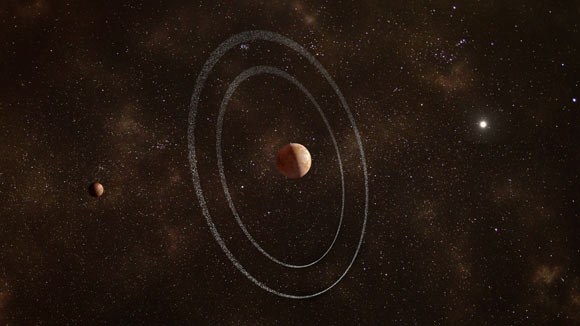Quaoar is a classical trans-Neptunian object with an equivalent diameter of 1,100 km.

An artist’s impression of Quaoar and its two rings. Quaoar’s moon Weywot is shown on the left. Image credit: ESA / Sci.News.
Quaoar was discovered on June 4, 2002 by California Institute of Technology astronomers Michael Brown and Chadwick Trujillo using images from the Palomar telescope.
Like the dwarf planet Pluto, this object dwells in the Kuiper Belt, an icy debris field of comet-like bodies.
It orbits at 45.1-45.6 astronomical units (AU) from the Sun and has an orbital period of 284.5 years.
Also known as 2002 LM60, Quaoar has one known moon, Weywot, that orbits at 24 Quaoar radii and has a diameter of about 80 km (50 miles).
Quaoar’s first ring, named Q1R, was detected during several stellar occultations observed between 2018 and 2021.
The new observations show that Quaoar’s ring system is more complex than previously thought.
“Rings are structures that attract people’s attention, especially the majestic rings of Saturn,” said Chrystian Luciano Pereira, a Ph.D. student at Brazil’s Observatório Nacional.
“Our work demonstrates that small bodies have rings that are even more curious than those observed on giant planets.”
“In addition, our work includes the participation of citizen astronomers, who helped make this unexpected astronomical discovery.”
On August 9, 2022, Pereira and his colleagues observed a stellar occultation to better understand the Q1R ring discovered a few months prior.
With the high-resolution imaging power of the ‘Alopeke instrument on Gemini North, one half of the International Gemini Observatory, operated by NSF’s NOIRLab, they were able to detect tiny variations in the star’s light as it passed behind Quaoar’s thin and tenuous ring system.
During these observations, the team was surprised when they unintentionally discovered a second ring, named Q2R, orbiting in between Quaoar and Q1R.
Unlike the rings observed around Chariklo, Haumea, and the four giant planets, Quaoar’s rings lie in a region well beyond what is known as the Roche limit.
According to the theory proposed by French astronomer Édouard Albert Roche in 1848, anything orbiting inside the limit would disintegrate to form a ring of particles, whereas outside of the limit such rings of particles would rapidly cluster into compact satellites.
For Quaoar, the Roche limit is estimated to be 1,780 km from the center of the body.
Q1R orbits Quaoar at a distance of 4,060 km; Q2R orbits at a distance of 2,520 km and has a typical width of 10 km.
And yet, despite being outside of the Roche limit, both rings remain as streams of particles rather than conglomerating into solid bodies.
How they are able to sustain this structure is still uncertain, though it is speculated that the relationship between the rotation speed of Quaoar and the orbital speeds of the rings may be an important factor, as has been proposed for the rings around Chariklo and Haumea.
Another unusual property of the Quaoar rings is the variability in Q1R’s width and opacity.
Observations of Q1R during the stellar occultation event revealed two distinct regions of the ring.
In one region, the stream of particles is a narrow, confined structure that is approximately 5 km wide and is opaque, meaning it’s quite dense.
In another region, the stream is wider, with an average width of 90 km, and has a thinner dispersion of particles that is less than 1% as opaque as the densest region.
“This type of structure had not yet been detected around small bodies in the Solar System,” Pereira said.
“One explanation for this confinement is that Q1R is being influenced by the presence of Weywot, a small moon that orbits Quaoar.”
“Q2R, on the other hand, has a consistent width of about 10 km throughout its structure.”
Regardless of what forces are at play here, the existence of Q1R and Q2R imply that the classical notion of the Roche limit may need to be revised for small planetary bodies.
“Roche’s proposed theory is robust to explain how a satellite is disrupted to form a ring when it gets too close to the central body,” Pereira said.
“A better understanding of this process would help us better understand the formation and evolution of our Solar System.”
The discovery is reported in a paper in the journal Astronomy & Astrophysics.
_____
C.L. Pereira et al. 2023. The two rings of (50000) Quaoar. A&A 673, L4; doi: 10.1051/0004-6361/202346365







![The image shows NGC 1866 superimposed with a false color image from the MUSE data cube, where the ionized shell of the planetary nebula Ka LMC 1 is seen as a red ring. The grayscale insets illustrate the different size of the ionized shells of singly ionized nitrogen [N II] and doubly ionized oxygen [O III]. The magnified Hubble image near the center of the ring reveals the presence of a pale blue star -- most probably the hot central star of Ka LMC 1. Image credit: AIP / M.M. Roth / NASA / ESA / Hubble.](https://cdn.sci.news/images/2025/11/image_14348-Ka-LMC-1-104x75.jpg)